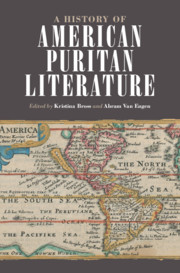Book contents
- A History of American Puritan Literature
- A History of American Puritan Literature
- Copyright page
- Dedication
- Contents
- Figures
- Contributors
- Acknowledgments
- Introduction
- Prologue
- Part I Places
- Part II Approaches
- Chapter 7 Theology
- Chapter 8 Aesthetics
- Chapter 9 Gender
- Chapter 10 Race
- Chapter 11 Print Culture
- Chapter 12 Ritual
- Chapter 13 Manuscript Culture
- Chapter 14 Environment
- Chapter 15 Science
- Chapter 16 Millennialism
- Chapter 17 Postsecularism
- Afterword
- Appendix
- Index
Chapter 8 - Aesthetics
from Part II - Approaches
Published online by Cambridge University Press: 24 September 2020
- A History of American Puritan Literature
- A History of American Puritan Literature
- Copyright page
- Dedication
- Contents
- Figures
- Contributors
- Acknowledgments
- Introduction
- Prologue
- Part I Places
- Part II Approaches
- Chapter 7 Theology
- Chapter 8 Aesthetics
- Chapter 9 Gender
- Chapter 10 Race
- Chapter 11 Print Culture
- Chapter 12 Ritual
- Chapter 13 Manuscript Culture
- Chapter 14 Environment
- Chapter 15 Science
- Chapter 16 Millennialism
- Chapter 17 Postsecularism
- Afterword
- Appendix
- Index
Summary
This chapter offers an understanding of puritan aesthetics by approaching it through the religious experience of conversion. Insofar as aesthetics are ever thought of in relation to puritanism, the usual scholarly conversation concerns the role, relevance, and consequences of the puritan plain style. Plain style matters, but it does not explain the broader aesthetic intentions or forms of puritan writing. Conversion comes much closer to the heart of it. Radical Protestants in early New England insisted that true religion began with the power of God acting on the individual to produce conversion to a new life of delight in God. The unconverted might seek to “prepare” themselves for that transformation of the heart, but predestinarian theology demanded that the crucial moment of change must be utterly external – a true work of God and not one of self-fashioning. In preaching, in poetry, and in personal conversion relations, puritans used the language of the heart to describe God’s power in conversion. This chapter traces how the response to sorrow and beauty characterizes puritan conversion stories from the first establishment of the colony of Massachusetts.
Keywords
- Type
- Chapter
- Information
- A History of American Puritan Literature , pp. 172 - 188Publisher: Cambridge University PressPrint publication year: 2020

